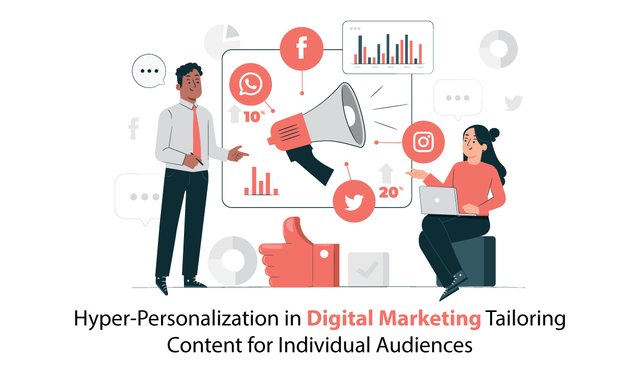In the rapidly evolving landscape of digital marketing, businesses are constantly seeking innovative ways to engage their audiences effectively. One of the most powerful strategies that has gained significant traction in recent years is hyper-personalization.
Unlike traditional marketing approaches, hyper-personalization involves tailoring content and marketing messages to meet the specific needs, preferences, and behaviors of individual customers. This personalized approach not only enhances user experience but also boosts customer satisfaction, loyalty, and conversion rates.

In this blog post, we will explore the concept of hyper-personalization in digital marketing and how businesses can leverage it to create meaningful connections with their audiences.
Understanding Hyper-Personalization
Hyper-personalization goes beyond basic personalization techniques. While personalization involves addressing customers by their names or recommending products based on their purchase history, hyper-personalization delves deeper into customer data. It utilizes advanced data analytics, artificial intelligence, and machine learning algorithms to analyze vast amounts of customer data, including online behaviors, preferences, social interactions, and demographic information, opined digital marketing professionals in Toronto.
By harnessing this wealth of data, businesses can create highly targeted and individualized marketing campaigns. These campaigns are not only relevant to the customer but also anticipate their needs and desires, providing a seamless and customized experience at every touchpoint.
Benefits of Hyper-Personalization
Enhanced Customer Experience: Hyper-personalized content ensures that customers receive messages and offers that align with their interests and preferences. This tailored approach creates a unique and memorable experience, making customers feel valued and understood.
Improved Engagement: Personalized content captures the attention of customers more effectively than generic messages. When customers see products or services that resonate with their interests, they are more likely to engage with the content, leading to higher click-through rates and interaction levels.
Increased Conversions: By presenting customers with products or services they are genuinely interested in, businesses can significantly increase conversion rates. Hyper-personalized recommendations guide customers toward making purchase decisions, resulting in higher sales and revenue.
Customer Retention: When customers receive content that reflects their preferences, they are more likely to remain loyal to the brand. Hyper-personalization strengthens the emotional connection between the customer and the brand, fostering long-term relationships and repeat business.
Data-Driven Insights: Hyper-personalization relies on comprehensive data analysis. By studying customer behaviors and responses, businesses gain valuable insights into consumer preferences. This data-driven approach enables businesses to refine their marketing strategies, ensuring continuous improvement and relevance.
Implementing Hyper-Personalization Strategies
Data Collection: The foundation of hyper-personalization lies in data. Businesses need to collect and consolidate data from various sources, such as website interactions, social media activities, and purchase histories. Advanced tools and technologies can help organize and analyze this data effectively.
Customer Segmentation: Once the data is collected, businesses can segment their audience into distinct groups based on common characteristics, behaviors, or preferences. These segments allow marketers to create targeted campaigns tailored to the specific needs of each group.
Behavioral Tracking: Implementing tools like cookies and tracking pixels enables businesses to monitor customer behavior in real-time. By understanding how customers navigate websites and interact with content, businesses can deliver personalized experiences and recommendations.
AI and Machine Learning: Artificial intelligence and machine learning algorithms analyze vast datasets to identify patterns and predict customer behavior. These technologies enable businesses to automate the process of personalization, ensuring that content is always relevant and up-to-date.
Multichannel Personalization: Hyper-personalization extends across multiple marketing channels, including email, social media, websites, and mobile apps. Consistent and personalized messaging across these channels creates a seamless experience for customers, reinforcing the brand's message and value proposition.
Challenges and Considerations
While hyper-personalization offers tremendous benefits, businesses must also address challenges such as data privacy and customer consent. With regulations like GDPR (General Data Protection Regulation) in place, it's essential to obtain explicit consent from customers before collecting and utilizing their data. Additionally, businesses must ensure the security of customer data to maintain trust and credibility.
Conclusion
In the digital age, where consumers are inundated with information, hyper-personalization stands out as a beacon of relevance and authenticity. By investing in advanced technologies and data-driven strategies, businesses can deliver tailored experiences that resonate with individual customers. Hyper-personalization not only enhances customer satisfaction and engagement but also drives conversions and fosters long-term loyalty.
As businesses continue to embrace the power of hyper-personalization, they are not just adapting to changing consumer expectations but also shaping the future of digital marketing. By understanding the unique needs of each customer and crafting personalized interactions, businesses can create meaningful connections that transcend traditional marketing approaches. In the era of hyper-personalization, the key to success lies in recognizing that every customer is not just a part of the audience but an individual with distinct preferences, and catering to these preferences is the path to sustainable growth and customer satisfaction.